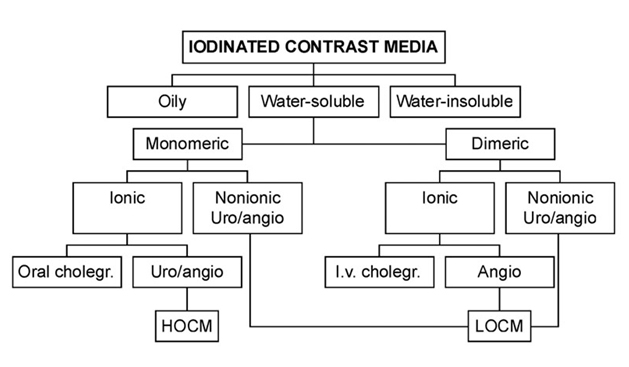IV Contrast
| 1. Why do we use IV contrast material? | |
| 2. Do you use serum creatinine levels or GFR in your practice for establishing risk prior to CT scanning? | |
| 3. What is GFR and why is it a more accurate measure than simply getting a creatinine level? | |
| 4. Why are GFR numbers different for Caucasians and African Americans? | |
| 5. Are all CT scans with IV contrast done the same way? | |
| 6. What type of IV contrast material do we use and why? | |
| 7. At what temperature do we store IV contrast material? | |
| 8. Why do you warm IV contrast? | |
| 9. What is the advantage of Visipaque as written in the literature? | |
| 10. When do you use Visipaque-320 and when Omnipaque-350? | |
| 11. Does the concentration of contrast mean that higher concentrations are better (AKA-isn’t a higher number better)? | |
| 12. What is the volume of IV contrast material we use? | |
| 13. What patients are considered high risk patients for IV contrast for CIN? | |
| 14. Do we have set cutoffs for creatinine levels and if so what are they? | |
| 15. Can we pretreat patients who have borderline renal function? If yes then how? | |
| 16. Should patients be NPO for CT scanning? If yes for how long? | |
| 17. What are the common volumes of contrast used for IV injection? | |
| 18. What kind of IV access is ideal for use for IV contrast injection? | |
| 19. Has there been any new developments in technology that may help us high injection rates in patients who can not tolerate an 18g needle (or at times even a 20g)? | |
| 20. Can any IV the patient has in place be used to inject the contrast material? | |
| 21. Can we use a central line or a PICC line for injection? | |
| 22. What about the new “purple PICC/central lines” I hear about? | |
| 23. What are some of the common normal “side effects” of IV contrast agents? | |
| 24. Is there a relationship between patients receiving chemotherapy and CIN? | |
 | 25. Is it ok for patients to have both an MR and a CT with contrast on the same day? |
| This question was addressed on the RSNA site and there is no issue doing both MRI and CT the same day with Gadolinium and Iodinated Contrast. Here is more detailed information courtesy of Richard A. Vitti MD from Medical Affairs at GE Healthcare. CT contrast, or X-ray contrast for IV use, is usually an iodinated compound, whereas most MRI contrast media contains a heavy metal ion usually gadolinium. Iodine provides contrast by virtue of absorption of X-rays at the K-edge. Gd provides contrast in MR by changing the magnetic moment. Generally these agents distribute themselves from the vascular space to the interstitial space of soft tissues, and are elminated by glomerular filtration by the kidneys.
References: Thomsen HS, Morcos SK. Radiographic contrast media. BJU International. 2000; 86: 1-10. Omnipaque Package Insert, 2011Gadolinium-based contrast agents (GBCAs) are composed of paramagnetic ions that change T1 (longitudinal) and T2 (transverse) relation rates of hydrogen protons within the body. Specifically they shorten T1 relaxation time increasing signal-to-noise ratios and making abnormalities appear bright compared to surrounding tissue. Most GBCAs approved use in the U.S. are extracellular agents which are distributed within the extracellular interstitial space. Commercially available GBCAs are either ionic or non-ionic. When injected an ionic molecule separates (dissociates), it can and will interact with other ions in the body, causing interference with normal physiologic processes (hypertonicity). Nonionic agents do not dissociate in solution so hypertonicity is avoided.
References:
| |
| 26. Have you ever seen a patient develop diffuse erythema distal to the IV injection site in the absence of extravasation? | |
| 27. Patients often report a metallic taste in their mouth following use of IV iodinated contrast. Is there an explanation? | |
| 28. Are there any contrast volume limitations for the use of IV contrast? | |
| 29. Can you tell me a bit more about GFR and what it really means? |

